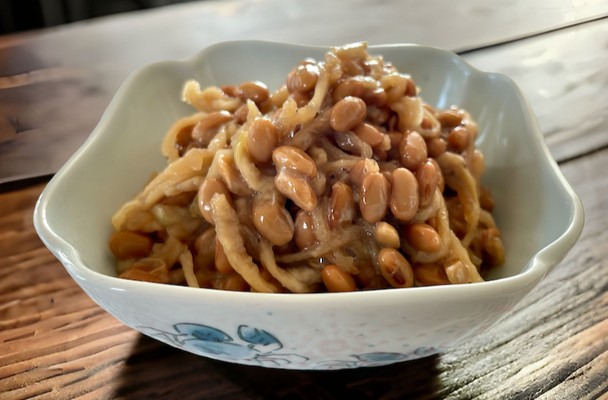Japanese food "natto" is a boom worldwide. Natto is traditional food fermented by 'Bacillus subtilis natto' fungus with soybeans that are softened by boiling and steaming, and generally refers to "itohiki natto" (sticky natto that leaves a melty cheese-like thread called '糸' / 'ito' in Japanese)). It is one of the basic and budget ingredients of Japanese food available throughout the year at food counters all over Japan.
The dish "soboro natto" (そぼろ納豆) we will introduct in this article is made of natto and dried radish (kiriboshi daikon or wariboshi daikon). "Soboro natto" is known in Japan as a local cuisine of Mito City, central Ibaraki Prefeccture. Now let's learn information about "Soboro natto" and how to make it!
What is a Japanese local cuisine?
Local cuisine (郷土料理 / Kyodo-ryouri) refers to dishes suitable for the climate that have been eaten in a local area for many years by using regional products. Many of them are comfort food and are popular among Japanese for domestic gourmet trips.
The origin and history of natto
There are various theories about the origin and birthplace of natto, but Mito City, Ibaraki Prefecture, has the most convincing one.
Mito's natto has a very long history. In 1083, when Minamoto no Yoshiie, a warlord of the Heian period, stayed at the residence of Watari town of Mito City on his way to Oshu, his servant made boiled beans for horse feed and wrapped them in straw. The rest of the boiled beans were fermented before they knew, and the beans were leaving sticky part like melty cheese. The servant later found out the beans were indeed surprisingly delicious, and Yoshiie was also very pleased. Since then, the custom of giving such beens to generals has spread. They are "beans to be given to the general" (将軍に納める豆 / shogun ni osameru mame), hence the name "natto" (納豆).
Origin of soboro natto
Soboro natto is a traditional dish of Mito City, combining natto and dried radish soaked together in salt and soy sauce. The dried radish (切り干し大根 / kiriboshi daikon - thinly cut then dried radish) is a dry food made by exposing the radish to cold wind for three days and freezing it in the night breeze on the last night.
The word "Soboro" of soboro natto generally refers to boiled pork or chicken fried until the juice from the meat is gone. In another meaning, the word also refers to "small things" or "finely chopped". By the way, "Soboro natto" is sometimes called "Oboro natto" or "Shoboro natto", both with the same meaning.
The reason for the birth of the soboro natto is that flourishing natto making and radish farming in Ibaraki Prefecture.
In Mito City, Ibaraki Prefecture, natto making was thriving as a way to eat soybeans that can be harvested before typhoons during the Edo period. At that time, there was a custom of making natto with soybeans harvested in the fall and distributing them to neighborhoods and temples. Various local dishes were born using natto so that people could eat surplus natto for a long time.
Soboro natto is also one of the local cuisine born from devising a way to enjoy surplus natto. Natto that is not cheese-like-sticky enough was mixed with the preserved food called kiriboshi daikon (to preserve radish) and salted - contributing to the prototype of the current soboro natto.
Soboro natto is easy to make, so it is often made as one of the home cooking dishes in modern times, whereas kiriboshi daikon is now often boiled and seasoned with soy sauce and mirin.
So far, we have introduced the history and origin of soboro natto. Next is how to make it! How about making one on your own?
Soboro natto recipe
Soboro natto ingredients (for 2 servings)
What is 'kiriboshi daikon' dried radish?
A 'kiriboshi daikon' dried radish is made by drying thinly sliced radish under the sun. The sunlight increases the sweetness and creates a unique crunchy texture. Generally, kiriboshi daikon is shredded into thin strips, but there is also a "wariboshi daikon" (割り干し大根 - splitted then dried radish) wichi uses thicker radish for a chewier texture.
- Kiriboshi daikon (dry) …… 15g
- Natto ... 2 packs
- Soy sauce (shoyu) ... 1 tablespoon
- Mirin ... 1 tablespoon
- Sake ... 1 tablespoon
How to make soboro natto
- Wash the kiriboshi daikon quickly and soak it in water for about 15 minutes.
- Squeeze the soaked kiriboshi daikon radish tightly to drain the water and cut it into appropriate sizes.
* You may cut with a kitchen knife or cut with scissors. - Put kiriboshi daikon, soy sauce, mirin, and sake in a frying pan or a small pot and heat on low heat. Fry the mixture with seasoning and make sure the seasoning is mixed over the whole.
- Stop the heat after the seasoning juice is gone. Put the natto in a bowl, pour the sauce and mustard (karashi) that come with natto packs over it, then add the stir-fried kiriboshi daikon.
- Mix them well and it is done.


Comments